Healthcare Decision-Making, Leadership, and Conflict Resolution Report
VerifiedAdded on 2021/04/24
|7
|1687
|64
Report
AI Summary
This report examines healthcare decision-making processes and conflict resolution strategies within the context of a homecare application. It begins by outlining the steps involved in healthcare decision-making, emphasizing the importance of clearly defining the problem, gathering relevant information, determining goals, considering consequences, making decisions, and evaluating outcomes. The report then explores leadership styles and their impact on conflict within organizations, using a case study of a home health company to illustrate how differing management approaches can lead to disagreements. It analyzes the application of rational decision-making models and negotiation models to resolve conflicts and improve organizational efficiency. The report also references several academic sources to support its arguments, providing a comprehensive overview of the key concepts and their practical implications in healthcare settings.
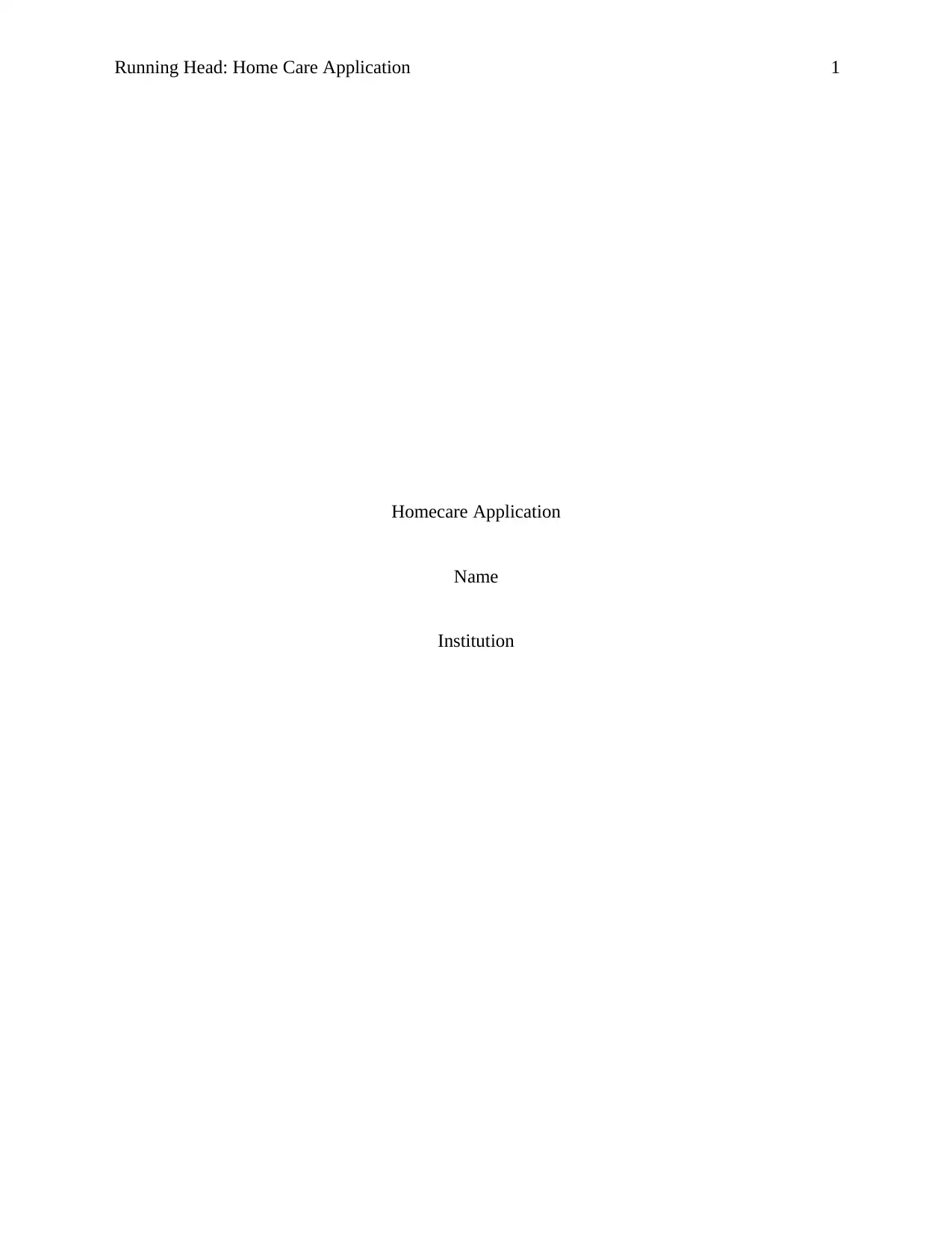
Running Head: Home Care Application 1
Homecare Application
Name
Institution
Homecare Application
Name
Institution
Paraphrase This Document
Need a fresh take? Get an instant paraphrase of this document with our AI Paraphraser
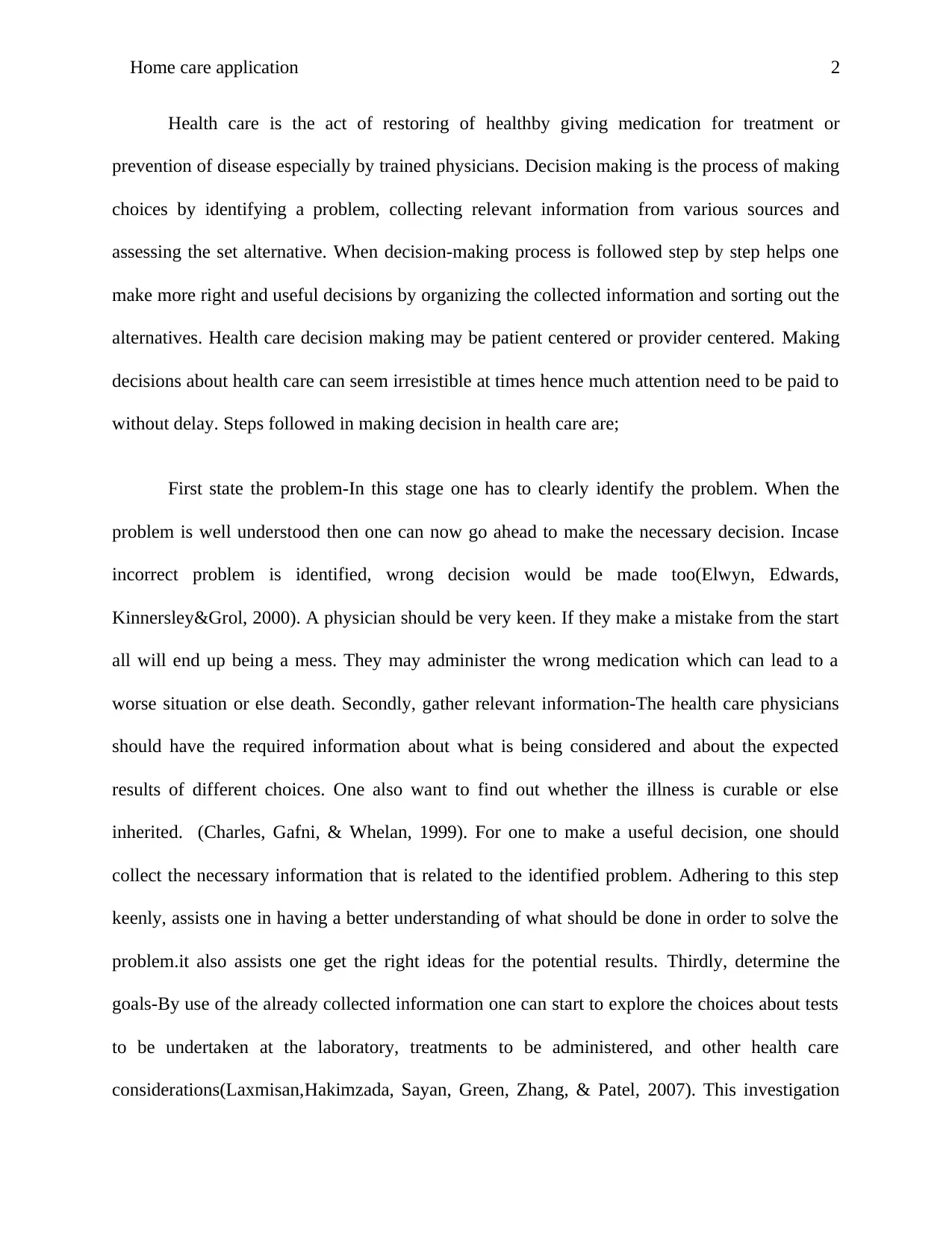
Home care application 2
Health care is the act of restoring of healthby giving medication for treatment or
prevention of disease especially by trained physicians. Decision making is the process of making
choices by identifying a problem, collecting relevant information from various sources and
assessing the set alternative. When decision-making process is followed step by step helps one
make more right and useful decisions by organizing the collected information and sorting out the
alternatives. Health care decision making may be patient centered or provider centered. Making
decisions about health care can seem irresistible at times hence much attention need to be paid to
without delay. Steps followed in making decision in health care are;
First state the problem-In this stage one has to clearly identify the problem. When the
problem is well understood then one can now go ahead to make the necessary decision. Incase
incorrect problem is identified, wrong decision would be made too(Elwyn, Edwards,
Kinnersley&Grol, 2000). A physician should be very keen. If they make a mistake from the start
all will end up being a mess. They may administer the wrong medication which can lead to a
worse situation or else death. Secondly, gather relevant information-The health care physicians
should have the required information about what is being considered and about the expected
results of different choices. One also want to find out whether the illness is curable or else
inherited. (Charles, Gafni, & Whelan, 1999). For one to make a useful decision, one should
collect the necessary information that is related to the identified problem. Adhering to this step
keenly, assists one in having a better understanding of what should be done in order to solve the
problem.it also assists one get the right ideas for the potential results. Thirdly, determine the
goals-By use of the already collected information one can start to explore the choices about tests
to be undertaken at the laboratory, treatments to be administered, and other health care
considerations(Laxmisan,Hakimzada, Sayan, Green, Zhang, & Patel, 2007). This investigation
Health care is the act of restoring of healthby giving medication for treatment or
prevention of disease especially by trained physicians. Decision making is the process of making
choices by identifying a problem, collecting relevant information from various sources and
assessing the set alternative. When decision-making process is followed step by step helps one
make more right and useful decisions by organizing the collected information and sorting out the
alternatives. Health care decision making may be patient centered or provider centered. Making
decisions about health care can seem irresistible at times hence much attention need to be paid to
without delay. Steps followed in making decision in health care are;
First state the problem-In this stage one has to clearly identify the problem. When the
problem is well understood then one can now go ahead to make the necessary decision. Incase
incorrect problem is identified, wrong decision would be made too(Elwyn, Edwards,
Kinnersley&Grol, 2000). A physician should be very keen. If they make a mistake from the start
all will end up being a mess. They may administer the wrong medication which can lead to a
worse situation or else death. Secondly, gather relevant information-The health care physicians
should have the required information about what is being considered and about the expected
results of different choices. One also want to find out whether the illness is curable or else
inherited. (Charles, Gafni, & Whelan, 1999). For one to make a useful decision, one should
collect the necessary information that is related to the identified problem. Adhering to this step
keenly, assists one in having a better understanding of what should be done in order to solve the
problem.it also assists one get the right ideas for the potential results. Thirdly, determine the
goals-By use of the already collected information one can start to explore the choices about tests
to be undertaken at the laboratory, treatments to be administered, and other health care
considerations(Laxmisan,Hakimzada, Sayan, Green, Zhang, & Patel, 2007). This investigation
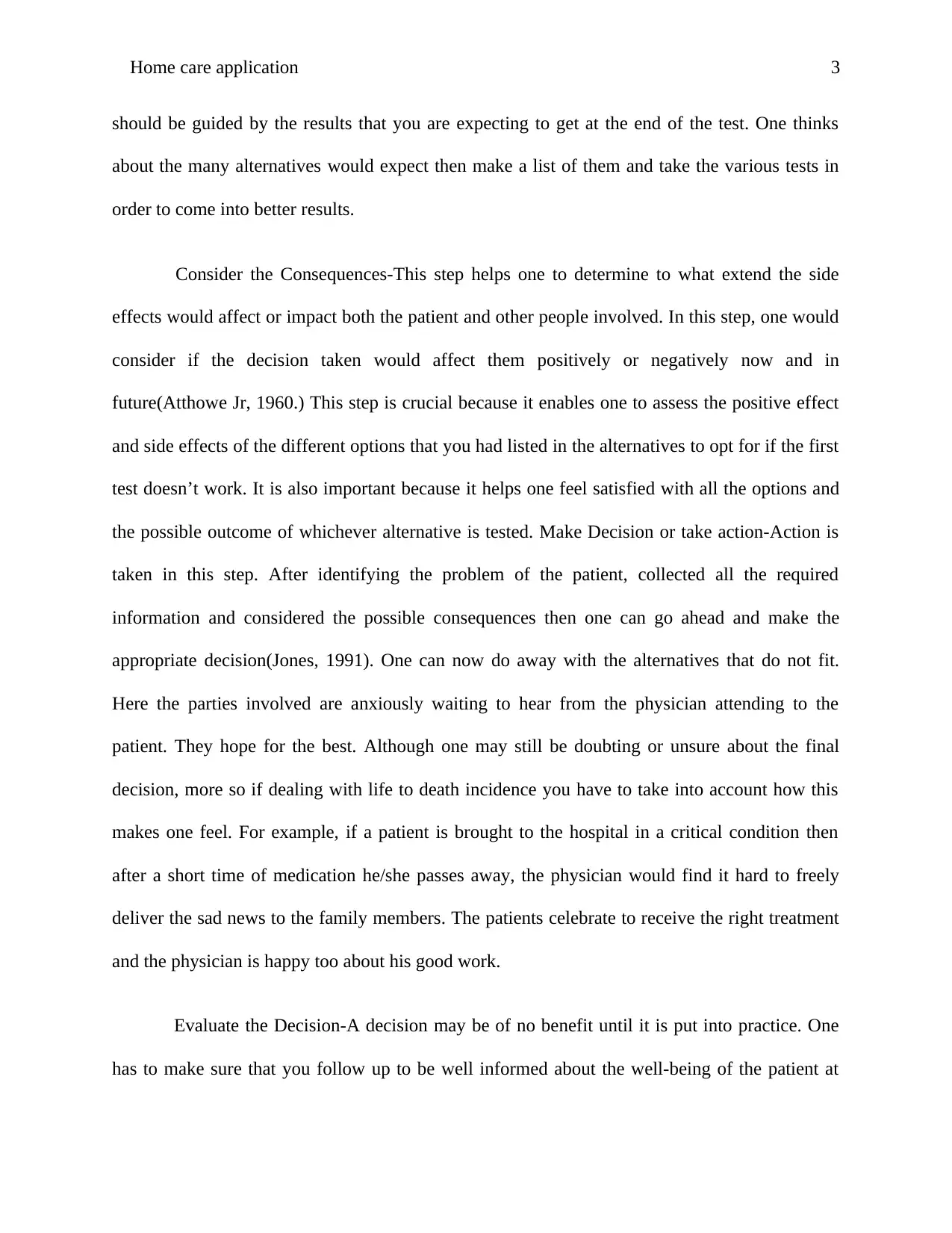
Home care application 3
should be guided by the results that you are expecting to get at the end of the test. One thinks
about the many alternatives would expect then make a list of them and take the various tests in
order to come into better results.
Consider the Consequences-This step helps one to determine to what extend the side
effects would affect or impact both the patient and other people involved. In this step, one would
consider if the decision taken would affect them positively or negatively now and in
future(Atthowe Jr, 1960.) This step is crucial because it enables one to assess the positive effect
and side effects of the different options that you had listed in the alternatives to opt for if the first
test doesn’t work. It is also important because it helps one feel satisfied with all the options and
the possible outcome of whichever alternative is tested. Make Decision or take action-Action is
taken in this step. After identifying the problem of the patient, collected all the required
information and considered the possible consequences then one can go ahead and make the
appropriate decision(Jones, 1991). One can now do away with the alternatives that do not fit.
Here the parties involved are anxiously waiting to hear from the physician attending to the
patient. They hope for the best. Although one may still be doubting or unsure about the final
decision, more so if dealing with life to death incidence you have to take into account how this
makes one feel. For example, if a patient is brought to the hospital in a critical condition then
after a short time of medication he/she passes away, the physician would find it hard to freely
deliver the sad news to the family members. The patients celebrate to receive the right treatment
and the physician is happy too about his good work.
Evaluate the Decision-A decision may be of no benefit until it is put into practice. One
has to make sure that you follow up to be well informed about the well-being of the patient at
should be guided by the results that you are expecting to get at the end of the test. One thinks
about the many alternatives would expect then make a list of them and take the various tests in
order to come into better results.
Consider the Consequences-This step helps one to determine to what extend the side
effects would affect or impact both the patient and other people involved. In this step, one would
consider if the decision taken would affect them positively or negatively now and in
future(Atthowe Jr, 1960.) This step is crucial because it enables one to assess the positive effect
and side effects of the different options that you had listed in the alternatives to opt for if the first
test doesn’t work. It is also important because it helps one feel satisfied with all the options and
the possible outcome of whichever alternative is tested. Make Decision or take action-Action is
taken in this step. After identifying the problem of the patient, collected all the required
information and considered the possible consequences then one can go ahead and make the
appropriate decision(Jones, 1991). One can now do away with the alternatives that do not fit.
Here the parties involved are anxiously waiting to hear from the physician attending to the
patient. They hope for the best. Although one may still be doubting or unsure about the final
decision, more so if dealing with life to death incidence you have to take into account how this
makes one feel. For example, if a patient is brought to the hospital in a critical condition then
after a short time of medication he/she passes away, the physician would find it hard to freely
deliver the sad news to the family members. The patients celebrate to receive the right treatment
and the physician is happy too about his good work.
Evaluate the Decision-A decision may be of no benefit until it is put into practice. One
has to make sure that you follow up to be well informed about the well-being of the patient at
⊘ This is a preview!⊘
Do you want full access?
Subscribe today to unlock all pages.

Trusted by 1+ million students worldwide
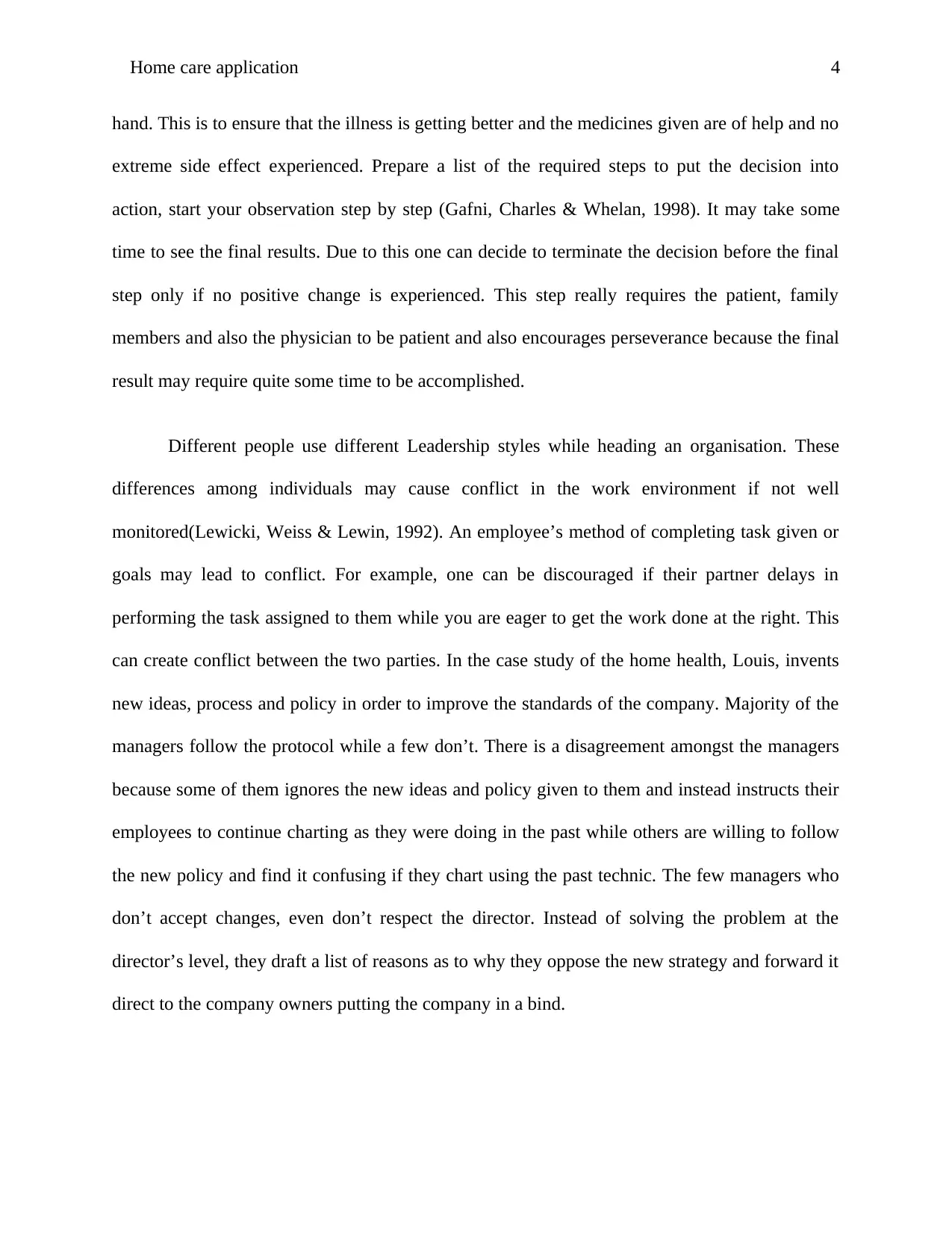
Home care application 4
hand. This is to ensure that the illness is getting better and the medicines given are of help and no
extreme side effect experienced. Prepare a list of the required steps to put the decision into
action, start your observation step by step (Gafni, Charles & Whelan, 1998). It may take some
time to see the final results. Due to this one can decide to terminate the decision before the final
step only if no positive change is experienced. This step really requires the patient, family
members and also the physician to be patient and also encourages perseverance because the final
result may require quite some time to be accomplished.
Different people use different Leadership styles while heading an organisation. These
differences among individuals may cause conflict in the work environment if not well
monitored(Lewicki, Weiss & Lewin, 1992). An employee’s method of completing task given or
goals may lead to conflict. For example, one can be discouraged if their partner delays in
performing the task assigned to them while you are eager to get the work done at the right. This
can create conflict between the two parties. In the case study of the home health, Louis, invents
new ideas, process and policy in order to improve the standards of the company. Majority of the
managers follow the protocol while a few don’t. There is a disagreement amongst the managers
because some of them ignores the new ideas and policy given to them and instead instructs their
employees to continue charting as they were doing in the past while others are willing to follow
the new policy and find it confusing if they chart using the past technic. The few managers who
don’t accept changes, even don’t respect the director. Instead of solving the problem at the
director’s level, they draft a list of reasons as to why they oppose the new strategy and forward it
direct to the company owners putting the company in a bind.
hand. This is to ensure that the illness is getting better and the medicines given are of help and no
extreme side effect experienced. Prepare a list of the required steps to put the decision into
action, start your observation step by step (Gafni, Charles & Whelan, 1998). It may take some
time to see the final results. Due to this one can decide to terminate the decision before the final
step only if no positive change is experienced. This step really requires the patient, family
members and also the physician to be patient and also encourages perseverance because the final
result may require quite some time to be accomplished.
Different people use different Leadership styles while heading an organisation. These
differences among individuals may cause conflict in the work environment if not well
monitored(Lewicki, Weiss & Lewin, 1992). An employee’s method of completing task given or
goals may lead to conflict. For example, one can be discouraged if their partner delays in
performing the task assigned to them while you are eager to get the work done at the right. This
can create conflict between the two parties. In the case study of the home health, Louis, invents
new ideas, process and policy in order to improve the standards of the company. Majority of the
managers follow the protocol while a few don’t. There is a disagreement amongst the managers
because some of them ignores the new ideas and policy given to them and instead instructs their
employees to continue charting as they were doing in the past while others are willing to follow
the new policy and find it confusing if they chart using the past technic. The few managers who
don’t accept changes, even don’t respect the director. Instead of solving the problem at the
director’s level, they draft a list of reasons as to why they oppose the new strategy and forward it
direct to the company owners putting the company in a bind.
Paraphrase This Document
Need a fresh take? Get an instant paraphrase of this document with our AI Paraphraser
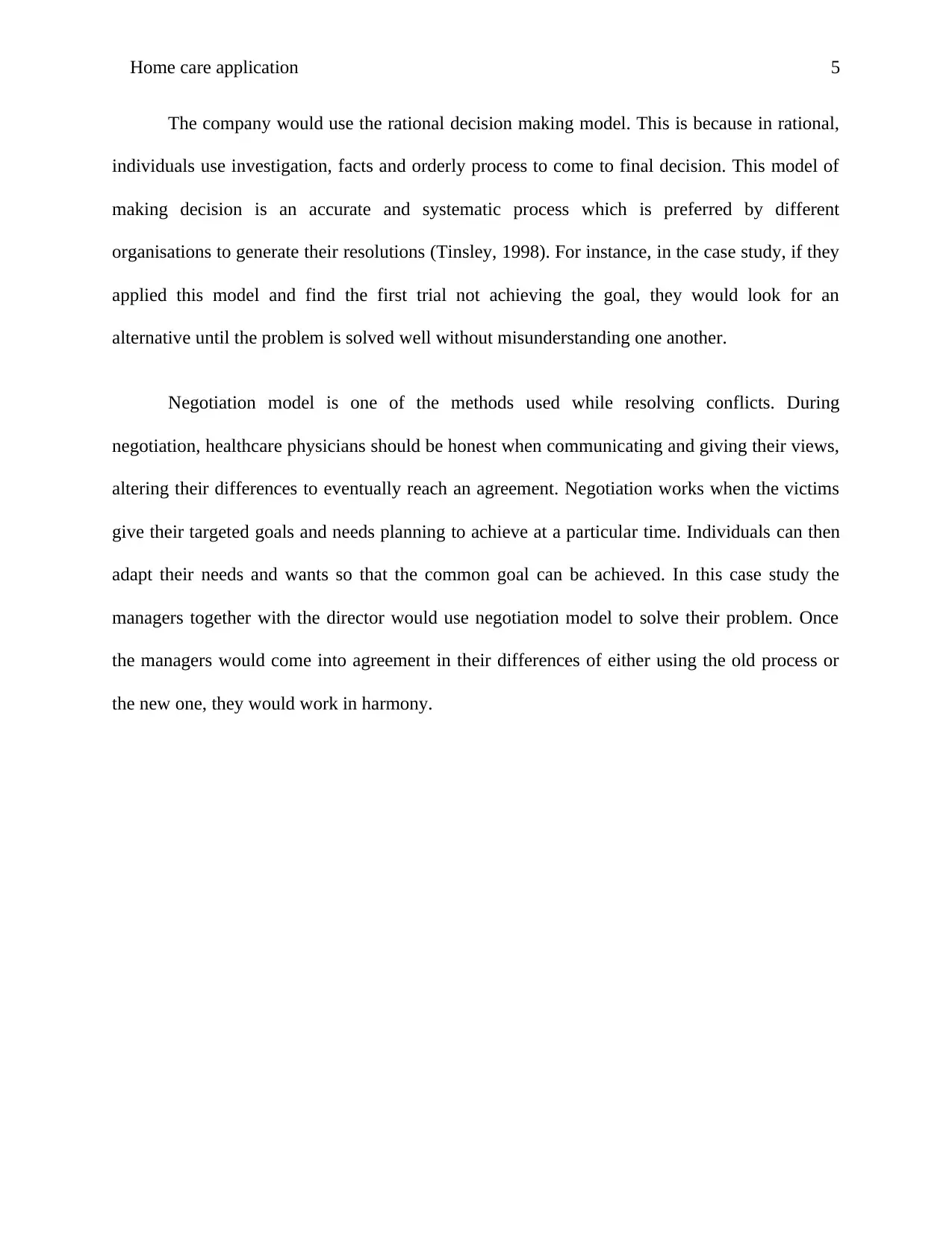
Home care application 5
The company would use the rational decision making model. This is because in rational,
individuals use investigation, facts and orderly process to come to final decision. This model of
making decision is an accurate and systematic process which is preferred by different
organisations to generate their resolutions (Tinsley, 1998). For instance, in the case study, if they
applied this model and find the first trial not achieving the goal, they would look for an
alternative until the problem is solved well without misunderstanding one another.
Negotiation model is one of the methods used while resolving conflicts. During
negotiation, healthcare physicians should be honest when communicating and giving their views,
altering their differences to eventually reach an agreement. Negotiation works when the victims
give their targeted goals and needs planning to achieve at a particular time. Individuals can then
adapt their needs and wants so that the common goal can be achieved. In this case study the
managers together with the director would use negotiation model to solve their problem. Once
the managers would come into agreement in their differences of either using the old process or
the new one, they would work in harmony.
The company would use the rational decision making model. This is because in rational,
individuals use investigation, facts and orderly process to come to final decision. This model of
making decision is an accurate and systematic process which is preferred by different
organisations to generate their resolutions (Tinsley, 1998). For instance, in the case study, if they
applied this model and find the first trial not achieving the goal, they would look for an
alternative until the problem is solved well without misunderstanding one another.
Negotiation model is one of the methods used while resolving conflicts. During
negotiation, healthcare physicians should be honest when communicating and giving their views,
altering their differences to eventually reach an agreement. Negotiation works when the victims
give their targeted goals and needs planning to achieve at a particular time. Individuals can then
adapt their needs and wants so that the common goal can be achieved. In this case study the
managers together with the director would use negotiation model to solve their problem. Once
the managers would come into agreement in their differences of either using the old process or
the new one, they would work in harmony.
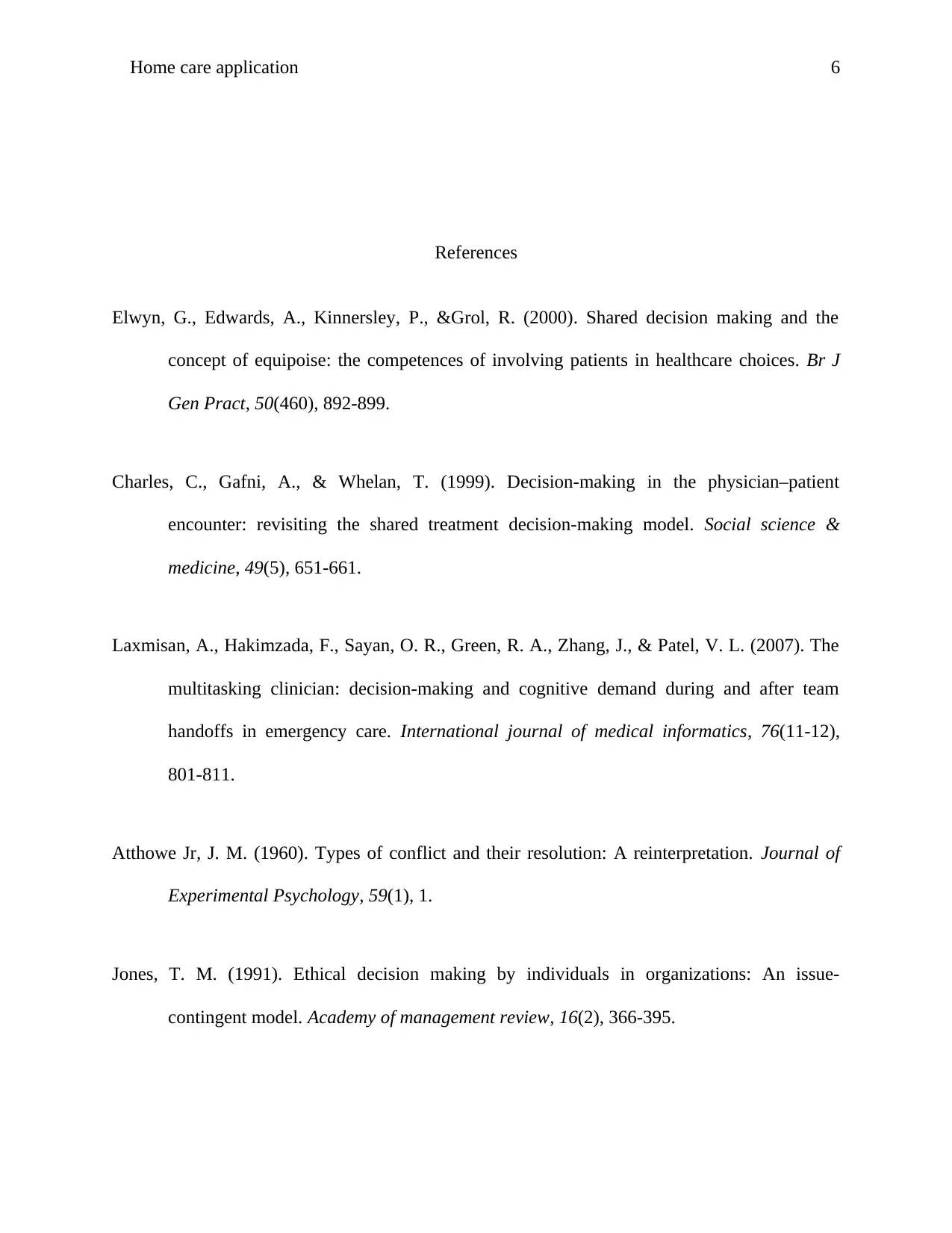
Home care application 6
References
Elwyn, G., Edwards, A., Kinnersley, P., &Grol, R. (2000). Shared decision making and the
concept of equipoise: the competences of involving patients in healthcare choices. Br J
Gen Pract, 50(460), 892-899.
Charles, C., Gafni, A., & Whelan, T. (1999). Decision-making in the physician–patient
encounter: revisiting the shared treatment decision-making model. Social science &
medicine, 49(5), 651-661.
Laxmisan, A., Hakimzada, F., Sayan, O. R., Green, R. A., Zhang, J., & Patel, V. L. (2007). The
multitasking clinician: decision-making and cognitive demand during and after team
handoffs in emergency care. International journal of medical informatics, 76(11-12),
801-811.
Atthowe Jr, J. M. (1960). Types of conflict and their resolution: A reinterpretation. Journal of
Experimental Psychology, 59(1), 1.
Jones, T. M. (1991). Ethical decision making by individuals in organizations: An issue-
contingent model. Academy of management review, 16(2), 366-395.
References
Elwyn, G., Edwards, A., Kinnersley, P., &Grol, R. (2000). Shared decision making and the
concept of equipoise: the competences of involving patients in healthcare choices. Br J
Gen Pract, 50(460), 892-899.
Charles, C., Gafni, A., & Whelan, T. (1999). Decision-making in the physician–patient
encounter: revisiting the shared treatment decision-making model. Social science &
medicine, 49(5), 651-661.
Laxmisan, A., Hakimzada, F., Sayan, O. R., Green, R. A., Zhang, J., & Patel, V. L. (2007). The
multitasking clinician: decision-making and cognitive demand during and after team
handoffs in emergency care. International journal of medical informatics, 76(11-12),
801-811.
Atthowe Jr, J. M. (1960). Types of conflict and their resolution: A reinterpretation. Journal of
Experimental Psychology, 59(1), 1.
Jones, T. M. (1991). Ethical decision making by individuals in organizations: An issue-
contingent model. Academy of management review, 16(2), 366-395.
⊘ This is a preview!⊘
Do you want full access?
Subscribe today to unlock all pages.

Trusted by 1+ million students worldwide
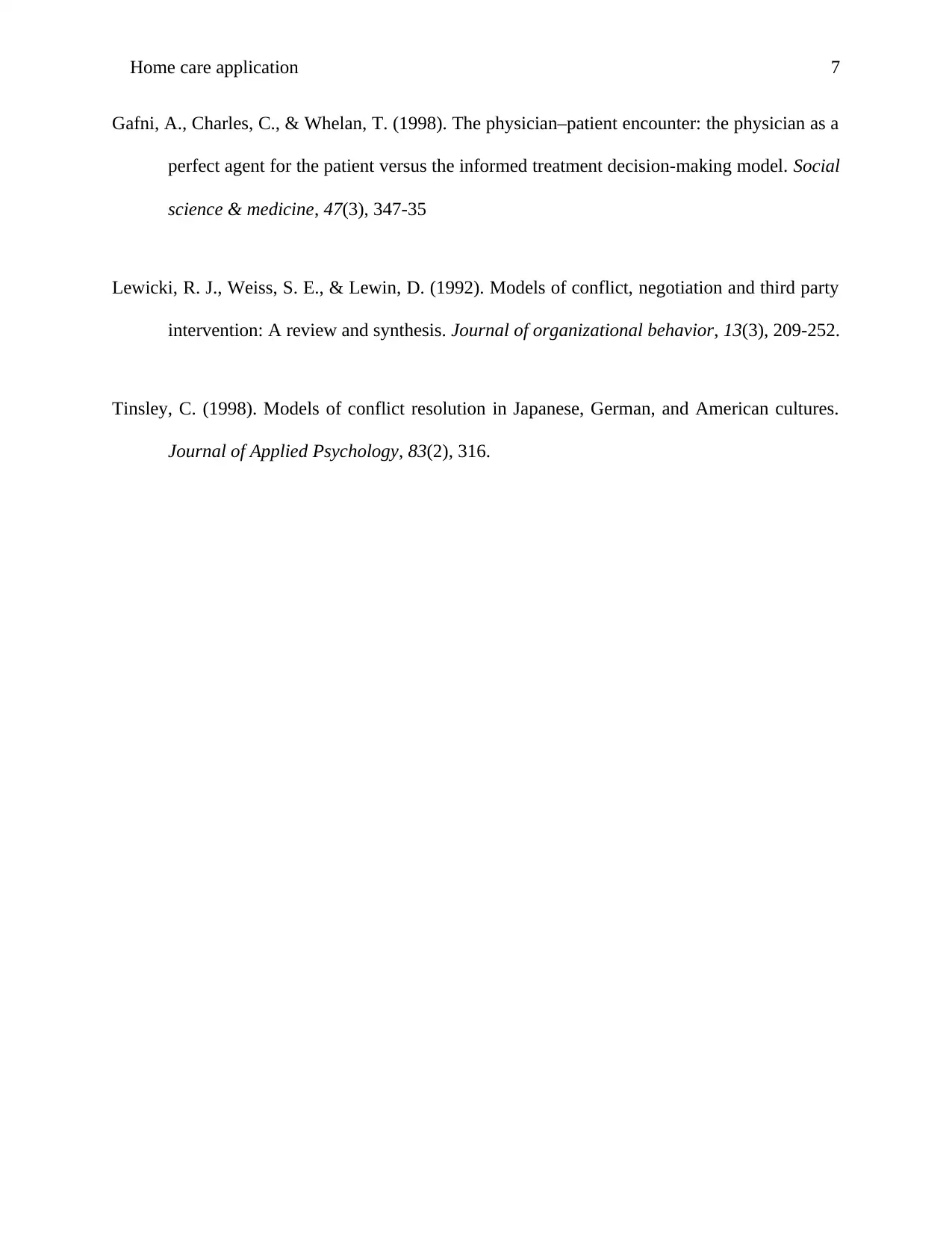
Home care application 7
Gafni, A., Charles, C., & Whelan, T. (1998). The physician–patient encounter: the physician as a
perfect agent for the patient versus the informed treatment decision-making model. Social
science & medicine, 47(3), 347-35
Lewicki, R. J., Weiss, S. E., & Lewin, D. (1992). Models of conflict, negotiation and third party
intervention: A review and synthesis. Journal of organizational behavior, 13(3), 209-252.
Tinsley, C. (1998). Models of conflict resolution in Japanese, German, and American cultures.
Journal of Applied Psychology, 83(2), 316.
Gafni, A., Charles, C., & Whelan, T. (1998). The physician–patient encounter: the physician as a
perfect agent for the patient versus the informed treatment decision-making model. Social
science & medicine, 47(3), 347-35
Lewicki, R. J., Weiss, S. E., & Lewin, D. (1992). Models of conflict, negotiation and third party
intervention: A review and synthesis. Journal of organizational behavior, 13(3), 209-252.
Tinsley, C. (1998). Models of conflict resolution in Japanese, German, and American cultures.
Journal of Applied Psychology, 83(2), 316.
1 out of 7
Related Documents
Your All-in-One AI-Powered Toolkit for Academic Success.
+13062052269
info@desklib.com
Available 24*7 on WhatsApp / Email
![[object Object]](/_next/static/media/star-bottom.7253800d.svg)
Unlock your academic potential
Copyright © 2020–2025 A2Z Services. All Rights Reserved. Developed and managed by ZUCOL.





